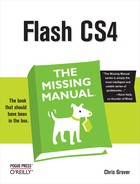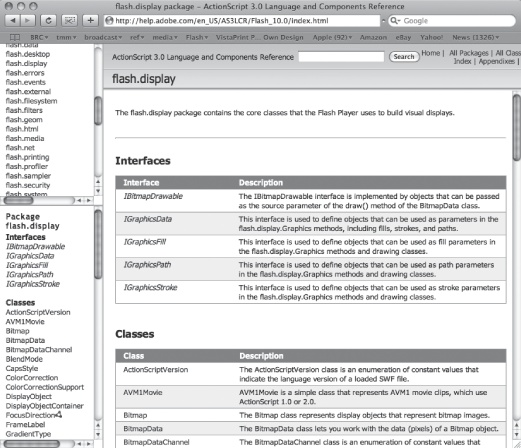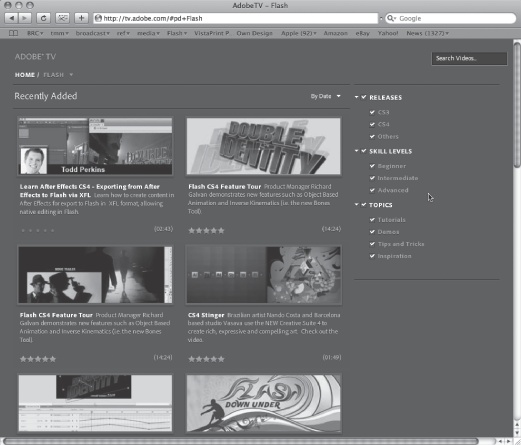It’s 2:00 a.m., you’re this close to finishing your animation, and you run into a snag. If you can’t find the answer to your question in the pages of this book, you have plenty of other possibilities. First of all, Flash has its own built-in Help system, which may give you the answer you need on the spot. For more complex problems, you can seek technical support from the developer (Adobe, as mentioned on Getting Help from Adobe) or from fellow Flash fans via the Web. This appendix outlines all these options.
First, in case you need help getting Flash installed on your computer, some basic instructions follow.
While the Flash box lists minimum requirements, minimum is the operative word. You’ll want at least 20 GB free on your hard disk—not just for the program installation, but to give you room to create and store your Flash masterpieces and import additional files (like previously created images, sound files, and movies) from elsewhere.
Adobe lists the minimum amount of computer memory as 1 GB for both Macs and PCs, but as usual, you won’t be sorry if you have twice that amount. The same is true of processor speed. For a PC, the minimum requirement is a 1 GHz processor (not much of a stress for today’s new computers). If you have a PC that’s 4 or 5 years old, you may want to double-check the processor speed. For Macs, the requirement is a PowerPC G5 or one of the newer Macs with a multicore Intel processor. Last, and certainly not least, is screen size. The minimum is listed as 1024 x 768 pixels. Again, most of today’s PCs and Macs, even laptops, meet this requirement. Flash has so many windows and panels, it’s great to have a system with more than one monitor or one very large display. It’s great to be able to display multiple panels, the Flash stage, and the Actions window without having to open, close, and then reopen them all of the time.
As with most programs, before you can use Flash, you need to install it on your computer and activate it. Fortunately, this one-time process is fairly painless. To get started, grab your Flash installation DVD and the jacket that it comes in. (You need the jacket because it contains the serial number you need to activate Flash.)
Then follow these steps:
Close any other programs you have open.
Flash demands all your computer’s attention during the installation and configuration process, so you don’t want any other files or programs open when it installs.
Insert the Flash installation disc into your CD/DVD drive.
If you’re in Windows, the installation screen appears automatically.
If you’re on a Mac, you have an extra step: On the desktop, double-click the CD/DVD icon; then double-click the name of installation program (for example, FL_Client_Installer). The installation screen appears.
Note
If the installation screen doesn’t appear when you insert your Flash installation disk (and you’re running Windows), click Start → My Computer, and then double-click the drive letter for your CD or DVD drive. The installation disc’s contents—including something called a Setup file—appear in your My Computer window. Double-click the Setup file to start the installation.
Follow the onscreen installation instructions on the next few screens, telling Flash that you accept its license agreement (you can’t install the program unless you do), and confirming that you want to install the free Flash Player plug-in.
When you finish, a message appears to let you know you’ve successfully installed Flash.
Launch your newly installed copy of Flash.
You can use any of the methods described on Starting Flash, like the Start menu (Windows) or the Dock (Mac).
The first time you launch the program, it asks you for your serial number.
Type your serial number, and then click Next to activate your copy of Flash.
An optional registration screen appears.
If you wish to register, type your name, your email address, and the country where you’re located.
Registering your copy of Flash gives Adobe a record of your purchase in case you run into any snags down the line.
Click Finish.
You’re good to go.
In the olden days of computing, software companies provided nice thick paperback manuals with their programs. They weren’t always well-written, and sometimes they were downright wrong, but at least you could read them on the bus or train on the way to work or school. These days, companies, including Adobe, provide book-length help files either in the program or online. If you want printed pages, crank up your printer and load up a ream or two of paper. The descriptions are more up to date and accurate than they were in those old printed volumes, but they’re often a bit cryptic, as if the software engineers who designed the programs wrote them. Funny, that.
On the positive side, electronic help documents let you use your computer’s search capabilities to hunt down an answer. Flash stores some help files on your computer when you install the program. However, if your computer is connected to the Internet, Flash automatically shows you Web-based help files, since they’re likely to be the most current.
The Help page lets you search the Flash and ActionScript documentation you automatically installed on your computer when you installed Flash.
To use the Help page:
Select Help → Flash Help or press F1.
The Help page in Figure A-1 appears. This first help page provides links to several different help resources. In the upper-left corner, you see several help resources listed, including:
Using Flash. The help system for using the Flash authoring system.
ActionScript 3.0 and Components. Two different help systems with specific information about ActionScript and the prebuilt components supplied with Flash. Use this reference when you’re writing ActionScript code and need to look up the properties and methods for specific ActionScript classes.
ActionScript 2.0 and Components. Help systems devoted to these earlier Flash tools.
Adobe AIR. A help system focusing on the needs of Adobe Air developers.
Flash Lite. A help system for developers building animations and programs to be used with handheld computers and devices.
Extending Flash. Help materials for folks writing and developing Flash components.
Below the links to the resources, you see the chapter outline for Using Flash. Click the + buttons to expand the chapter outline to see the subsections.
In the middle of the screen, you see a link and a logo for Community Help. Click here, and you can search the forums where other Flash developers discuss problems and solutions, which may not be your best bet for immediate answers to a question. You should probably check Using Flash first. Then if you can’t find an answer or you need more details, go ahead and turn to Community Help.
In the search box, type the word or phrase with which you need help.
Flash displays a list of topics in the left-hand side of the Help page.
Click the topic that looks like the closest match to what you’re searching for.
Flash displays the text for that topic in the Help page’s right-hand side. You may have to repeat this step several times to zero in on the information you want. The word or phrase you typed in the search box is highlighted in the Flash text, which makes it easier to find the pertinent details in the longer help articles.
When you’re writing ActionScript code, it’s not just helpful to have a reference close at hand, it’s necessary. Even experienced ActionScripters need to look up the class definitions for new objects. You’ll often come across a class, property, or method that you haven’t used before.
Select Help → Flash Help or press F1.
Flash opens your Web browser and displays the help page shown in Figure A-1.
Select ActionScript 3.0 and Components.
A new page appears in your browser listing a three ActionScript help resources. The first two references are written in paragraph form. While you can’t call them verbose, they do provide some helpful descriptions about certain ActionScript techniques. The third book is a dictionary-style reference book:
Programming ActionScript 3.0. A general help reference for ActionScript 3.0 that explains in prose how to work with ActionScript.
Using ActionScript 3.0 Components. A general help reference for components that explains in prose how to add components to your Flash animations.
ActionScript 3.0 Language and Component Reference, A dictionary-style reference book listing every class along with the properties and methods. If you’re looking for a quick answer about a specific class, this is the help system to search.
Choose ActionScript 3.0 Language and Component Reference.
The ActionScript 3.0 reference opens in your Web browser (Figure A-2).
If you know the name of the “package” that holds the class you’re researching, click its name in the upper-left cover. Otherwise, type the name of the class, property, or method in the search box at the top of the page.
The details about ActionScript classes appear in main part of your browser window. Hyperlinks abound, so don’t be afraid to click words to jump to other parts of this reference. You can always use the Back button in your browser to backtrack to previous pages.
Making good use of their own tools, Adobe serves up AdobeTV, where you can find video tutorials for Flash and other Creative Suite 4 programs. The company seems to be adding new programs, tutorials, and demonstrations all the time. Go to http://tv.adobe.com, and you’ll see a page like Figure A-3. You can use the search box to hunt down videos on a particular topic, or you can select an index based on specific Adobe products. For beginners, the series “Flash in a Flash” is a good place to start.
Adobe offers a variety of technical support options, from free to for-a-fee.
Adobe maintains a Web site containing articles on Flash, as well as sample code and answers to frequently asked Flash-related questions. You can get there quickly through the Help menu: Help → Flash Support Center. You’ll find lots of articles and tutorials. If you’re looking for more advanced help, check out the Developer Centers listed in the column on the right side of the page. There are Developer Centers for Adobe AIR for Flash, Flash, Flash Lite, Flash Media Server, and Flash Player.
If you’re interested in creating animations that folks can play on mobile devices like mobile phones and PDAs, check out the Mobile and Devices Developer Center at www.adobe.com/devnet/devices/flashlite.html.
Adobe hosts online forums, where anyone can ask a question about Flash, and anyone can answer. User-to-user means that Adobe employees don’t officially monitor the forums or answer any questions, so the feedback you get has no official sanction or guarantee of accuracy. Still, the best and fastest answers and advice often come from other folks in the trenches, so if you’ve worked your way through Adobe’s Tech Notes, Knowledgebase (online articles), FAQs, and documentation, these forums (Help → Adobe Online Forums) are definitely worth a look.
Sometimes, nothing will do but asking a real live technical support person for help. Adobe sells several different pay-to-play support plans. For example, single-incident support costs $39, or you can purchase a 5-Incident Pack for $175. If you’d like a years worth of unlimited support it costs $1200. Go to www.adobe.com/support/programs/flash for the details.
Flash is one of those programs that people tend to get passionate about, so it’s not surprising that there are hundreds of great resources on the Web offering everything from example code to free components, articles, tutorials, and more.
Here are a few that are definitely worth checking out:
FlashGuru (www.flashguru.co.uk). With its professional-quality articles and tutorials, this wondrous Flash blog would be useful enough by itself; but it also lists dozens of other Flash blogs maintained by heavy-hitters in the Flash world.
Flash Kit(www.flashkit.com). Surprisingly badly designed for a site that focuses on a design program, Flash Kit nevertheless offers a wealth of sound effects, fonts, components, and movie clips. It also hosts a well-attended online forum.
Best Flash Animation Site (www.bestflashanimationsite.com) and Webby Awards (www.webbyawards.com). There’s nothing like watching a beautifully constructed Flash animation to get you thinking about good design. On these two sites you can nominate the coolest Flash animation you’ve ever seen (including your own) or simply visit the sites others have nominated.
Boston Adobe Mobile and Devices User Group(www.flashmobilegroup.org). If you’re interested in creating Flash content for mobile devices (like mobile phones), you’ll want to check out this site, which offers Flash Lite–specific articles, seminars, links, and live chats.
FlashPro Mailing list (www.muinar.org). FlashPro is an open and nonmoderated email list “for professional Flash designers and ActionScript coders.” This is where the big dogs run, so you may want to exhaust some of the resources listed above (and comb through FlashPro’s archived posts) before posting a question.
ActionScript dot Org (www.actionscript.org ). If you’re interested in all things ActionScript, this site offers tutorials, articles, and forums populated by ActionScript programmers. Once you’ve earned your stripes there are even job listings where you can put your newfound skills to work.



